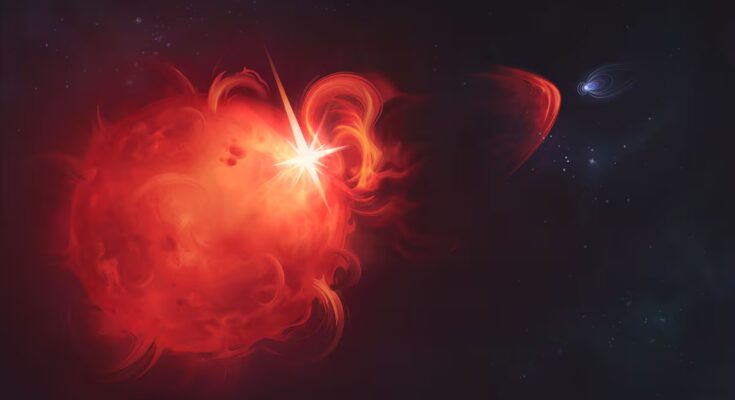For years, astronomers have observed the stars, wondering whether violent storms like those shaking the Sun could erupt elsewhere in the universe. The Sun often launches giant clouds of plasma – known as coronal mass ejections (CMEs) – into space that can disrupt space weather, create dazzling auroras or shake satellites orbiting Earth. But other than the Sun, no one had ever observed another celestial body do the same… until now. An international team of astronomers, combining the clear vision of the LOFAR radio telescope with the European Space Agency’s (ESA) XMM-Newton space observatory, has detected for the first time a massive stellar explosion on a star outside our cosmic neighborhood, the solar system.
The star at the center of this event is a red dwarf called StKM 1-1262, located about 40 light-years from Earth, according to a new study published Wednesday in Nature. Smaller and cooler than the Sun, the star unleashed an eruption consisting of a burst of radio waves – essentially extremely powerful, short bursts of energy – that traveled through space, indicating that a colossal ejection of magnetized plasma had exploded from its surface.
“The magnetic explosion occurred in 1883 and the light from that event only reached us in 2016, when we detected it,” Cyril Tasse, researcher at the Paris Observatory in France and co-author of the discovery, told EL PAÍS.
The study covered the sky of the Northern Hemisphere and analyzed each region for eight consecutive hours. When a stellar CME moves from the corona (the outermost layer of its atmosphere) into space, it generates a shock wave. Recent research indicates that the explosion was so violent that any nearby planet would likely have lost its entire atmosphere. Tasse recalls that the expulsion lasted about a minute.
“The star was in that position, so there wasn’t much discussion. We knew it was an explosion,” he adds.
The discovery was not a matter of luck. Behind that solitary explosion lie years of meticulous work and advanced technology. It was precisely the “scream” of the plasma that finally detected LOFAR, the network of antennas spread across Europe designed to capture the lowest frequencies in the sky. According to scientists, a signal like this would not exist if the material had not been completely ejected from the star’s magnetic bubble.
To estimate the extent of the phenomenon, the researchers applied models similar to those used to study the Sun, but adapted to the conditions of this red dwarf. They developed a technique to study all the stars in the field of view simultaneously, which Tasse likens to throwing a fishing net into the sea “to try to catch as many fish as possible.” Measurements revealed that the ejected plasma was traveling at around 2,400 kilometers per second. Without this data analysis technique, developed at the Paris Observatory, it would have been impossible to locate the star.
Such speeds – unthinkable for most solar flares – are observed only in the Sun’s most extreme events, although such a shock has never occurred. If this were the case, humanity would be in serious danger. Although the red dwarf has about half the mass of the Sun, rotates 20 times faster and has a magnetic field 300 times stronger, events in this type of star can be much more frequent and intense.
The best-known exoplanets orbit stars like StKM 1-1262, making these discoveries crucial to understanding our galaxy. Benjamín Montesinos, an astrophysicist at the Spanish Astrobiology Center (CSIC), notes that red dwarfs were already known to have strong magnetic activity, especially when they were young. “Until now, flares have been observed in X-ray, ultraviolet and optical wavelengths. What is new is the detection in radio, which integrates these observations and allows a direct comparison with solar phenomena,” says Montesinos, who was not involved in the study.
A magnetic monster
The discovery raises serious questions about the habitability of worlds orbiting red dwarfs, the most common stars in the Milky Way and home to the best-known exoplanets. A planet constantly bombarded by powerful CMEs could lose all of its atmosphere and be reduced to barren, uninhabitable rock. Cyril Tasse explains: “For liquid water to exist on the surface of a planet, the temperature must remain adequate, and this depends on the greenhouse effect. This happens when the atmosphere traps some of the star’s energy.”
But receiving the right amount of light is not enough; a heat-retaining atmosphere is also needed. “The Holy Grail for researchers now is to find Earth-like planets orbiting Sun-like stars,” adds Montesinos.
The new study also broadens understanding of space weather in general, an area of research that the European Space Agency has followed for decades. Launched in 1999, XMM-Newton has been instrumental in studying the extreme environments of the universe, from galactic nuclei to bursts of radiation from distant stars and galaxies. Tasse revealed that his team has detected other types of signals: “We believe we are seeing auroras on exoplanets, in radio waves, which is interesting.”
It’s not just the Sun that hurls fire into the void. Other stars do it too. And this discovery, more than just an astronomical observation, opens a new window into understanding how life is forged on surrounding worlds – and how it might simultaneously become extinct.
Sign up to our weekly newsletter to get more English-language news coverage from EL PAÍS USA Edition



